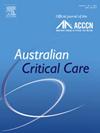澳大利亚重症监护病房收治的 COVID-19 患者的行政记录种族与治疗结果之间的关系
IF 2.7
3区 医学
Q2 CRITICAL CARE MEDICINE
引用次数: 0
摘要
背景:在澳大利亚,种族与COVID-19危重患者死亡率之间的关系尚未得到描述。确定严重COVID-19风险最高的社区可能有助于制定有效的公共卫生政策,并可能改善澳大利亚医疗保健的公平提供。本研究的目的是描述澳大利亚重症监护病房确诊COVID-19感染的行政记录族裔的基线特征、治疗和结局。方法对2020年2月至2022年5月参加澳大利亚严重急性呼吸道感染短期发病率研究的78个重症监护病房主要因COVID-19入院的成年患者进行回顾性、多中心、队列分析。主要结局指标为住院死亡率。结果4621例重症监护患者中,种族占比依次为白人(38%)、中东(15%)、亚洲(10%)、其他(10%)、原住民和托雷斯海峡岛民(3.3%)、黑人(1.1%)、未知(22%)。在大流行期间,每组之间的疫苗接种率、机械通气率和入院率差异显著(p <;0.01)。然而,在根据年龄、体重指数、急性生理和慢性健康评估II、共存疾病的数量、从医院到重症监护住院的时间、疫苗接种、机械通气和中心的使用以及入院周作为随机效应进行调整后,与死亡率独立相关的唯一种族是“其他”组(风险差异:5.27[置信区间:0.54至10.01],p = 0.029)。结论本研究表明,除“其他”组院内死亡率较高外,大多数族裔的COVID-19危重患者结局大致相似。本文章由计算机程序翻译,如有差异,请以英文原文为准。
The relationship between administratively recorded ethnicity and outcomes for people admitted to Australian intensive care units with COVID-19
Background
The relationship between ethnicity and mortality of patients critically ill with COVID-19 in Australia has not been described. Defining those communities at the highest risk of severe COVID-19 may assist with formulating effective public health policy and may improve the equitable delivery of health care in Australia.
Objective
The aim of this study was to describe the baseline characteristics, treatments, and outcomes of administratively recorded ethnic groups admitted to Australian intensive care units with confirmed COVID-19 infection.
Methods
This was a retrospective, multicentre, cohort analysis of adult patients admitted primarily due to COVID-19 to the 78 intensive care units participating in the Short Period Incidence Study of Severe Acute Respiratory Infection Australia from February 2020 to May 2022. The main outcome measure was in-hospital mortality.
Results
Of 4621 eligible patients admitted to intensive care units, the proportion of ethnic groups were White (38%), Middle Eastern (15%), Asian (10%), Other (10%), Aboriginal and Torres Strait Islander (3.3%), Black (1.1%), and Unknown (22%). Rates of vaccination, mechanical ventilation, and admission varied significantly between each group over the course of the pandemic (p < 0.01). However, after adjusting by age, body mass index, Acute Physiology And Chronic Health Evaluation II, the number of coexisting disorders, time from hospital to intensive care admission, vaccination, use of mechanical ventilation and centres, and week of admission as random effects, the only ethnicity independently associated with mortality was the “Other” group (risk difference: 5.27 [confidence interval: 0.54 to 10.01], p = 0.029).
Conclusion
This study demonstrates that the outcomes of patients critically ill with COVID-19 for most ethnic groups were broadly similar, with the exception of the “Other” group who had a higher in-hospital mortality rate.
求助全文
通过发布文献求助,成功后即可免费获取论文全文。
去求助
来源期刊

Australian Critical Care
NURSING-NURSING
CiteScore
4.90
自引率
9.10%
发文量
148
审稿时长
>12 weeks
期刊介绍:
Australian Critical Care is the official journal of the Australian College of Critical Care Nurses (ACCCN). It is a bi-monthly peer-reviewed journal, providing clinically relevant research, reviews and articles of interest to the critical care community. Australian Critical Care publishes peer-reviewed scholarly papers that report research findings, research-based reviews, discussion papers and commentaries which are of interest to an international readership of critical care practitioners, educators, administrators and researchers. Interprofessional articles are welcomed.
 求助内容:
求助内容: 应助结果提醒方式:
应助结果提醒方式:


